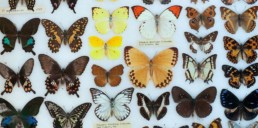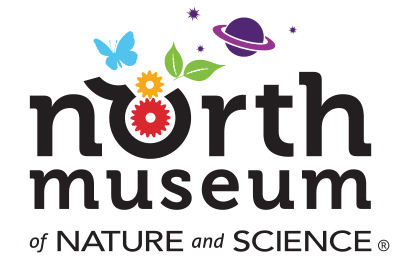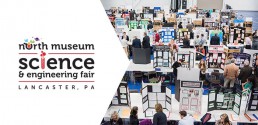Collections
Explore over 500 million years of history. North Museum of Nature and Science houses over 250,000 objects in its permanent collections. Sourced from all over the globe, these objects represent an amazing range of subjects, styles, time periods, cultures, disciplines, and taxonomy. The vast majority of objects housed represent the natural heritage of the Lower Susquehanna Region and the surrounding area.
The museum’s collections began with a group of local nature enthusiast who formed the Linnaean Society in 1862. To satisfy their desire to understand the world around them, this group of locals studied, collected and preserved thousands of specimens. The desire to learn never slackened and the group’s collections was added to by professors, scientists and other locals until it became the collection that it is today.

Ornithology
The North Museum has an outstanding collection of well over 1,000 taxidermy birds from all over the globe (including extinct species), thousands of eggs and a small collection so study skins. The Specimens also exhibit examples of both present day and pre-20th-century taxidermy, many of which are on exhibit in the Ornithology Room.
One of the oldest specimens in the collections is “Rosy”. This female Roseate Spoonbill is particularly interesting because she represents one of the oldest examples of taxidermy in Pennsylvania (1844) and she is the only Roseate Spoonbill ever recorded to have been seen in Lancaster County.

Paleontology
The Paleontology Collection contains thousands of local Paleozoic invertebrates and some vertebrate fossil specimens from around the world. The North Museum also preserves very important fossils from the local Kinzers Formation, invertebrates that document a time when many of the familiar animal body shapes were first evolving on Earth. Some type specimens in paleontology (those named by scientists as the standard for a species) are housed at the North Museum.
One of the Museum’s prized pieces is a fossil of Sphodrosaurus pennsylvanicus. The Sphodrosaurus pennsylvanicus was found locally in Bowmansville and is the only know one of its kind (a holotype).

Entomology
This collection is quite diverse and contains over 16,000 pinned, mounted and displayed specimens. It ranges from small individual specimens to historically important insect collections. Though some were collected relatively recently, the majority of the collection was acquired during the late 1800’s up into the early 1900’s. Some even have Linnaean Society members or Justin Roddy’s handwritten labels still attached.

Vertebrate
The North Museum has a good representative collections of mammalian osteology (bone and skull) specimens from mammals of Pennsylvania and the rest of the world. The materials illustrate the modern orders and many of the families of mammals. The collection also includes whole body specimens, smaller species mounted in plastic, a limited number of study skins, and some attractive and impressive taxidermy mounts, some of which are currently exhibited.
The collection also includes some Ichthyological (fish) and Herpetological (amphibian and reptile) specimens. A large sturgeon caught in the Susquehanna is one of the most popular items on display at the North Museum, both for its unusual occurrence and because it represents an example of very early taxidermy.

Botany
The Herbarium, probably the fourth largest in the State of Pennsylvania, documents most local species and their distribution within a regional and historical context. There are other discrete collections, including botanical material from Florida from a period before urbanization. Unusual material includes an extensive collection of seeds; these specimens can be useful for archaeologists analyzing sites that were once occupied by humans.

Archaeology and Anthropology
These two collections contain tools, vessels, textiles, and decorative pieces made by cultures including Native American, European, African and South American cultures. Combined with donated material from many geographic regions, the Museum’s Archaeological Collection includes extensive Pennsylvania survey materials discovered by former North Museum Director Dr. W. Fred Kinsey III. The collection contains over 100,000 items.
These fragile artifacts are housed in environmentally controlled areas of the Museum’s collections storage space. More recent local artwork (pertaining to natural history and exhibitions) is also retained as part of the Museum’s archives. The Native American collections are in the process of being reinterpreted and will be back on display in the future.

Marine
One of the Museum’s smaller collections, the Marine Collection contains some wonderful examples of corals, sponges, invertebrates and echinoderms.

Geology
The North Museum holds a very large rock and mineral collection. Many of the most impressive or interesting minerals are on display in the lower level.

Conchology
Two of the Museum’s strongest collections are the Mollusk and Land-Shell Collections. These sub-collections, of the Invertebrate Collection, embody a very important scientific value. These often ignored animals can be excellent monitors of changes in land use or environmental disturbances. The North Museum currently has over 15,000 shells in its collections.

Art and Archives
The North Museum‘s Art and Archives Collections are a small portion of the Museums holding. They include some pieces from Florence Starr Taylor and Jacob Stauffer. There is a beautiful stain glass window commemorating Kenneth Rydal John (1925-1982) and many photographs and journals from the early days of the Museum.

Education Collection
This collection is unique compared to the other collections. With these objects, visitors can touch, handle and examine them with their own senses. They can feel the soapy texture of talc stone, trace the outlines of trilobites, smell the lingering sent of pollen and hear the dry crackle of a nest. The other collections excite the imagination and grow our curiosity. This collection sparks that initial desire to learn.
The North Museum of Nature and Science Collections Statement of Purpose
Collections of the North Museum of Nature and Science reflect the cultural and natural history of south central Pennsylvania, and to a lesser extent, the world around it through the significant cultural and scientific objects that have been acquired by the Museum to further its mission as a premier educational institution and provide a window to the world. The collections document the history of the region in which the Museum exists. Collections are maintained by the Museum for use in its education, research, and public service activities.
Collections of the Museum are: 1) active repositories for significant artifacts and specimens acquired by the Museum; 2) cared for and preserved for use by present and future generations; 3) studied and documented to promote their understanding; 4) judiciously used to provide educational exhibits and programs for community schools and the general public of south central Pennsylvania and beyond, and 5) as appropriate, the collections may also be made available to support primary, secondary, college, and university curricula, and or loaned to other institutions under the terms of these policies.
- Are you interested in adding to our collections? Please click here to fill out a form about the object, items will not be accepted without it. The North Museum deeply appreciates your generosity. By accessioning something into our permanent collections, we are taking on the responsibility of caring for that item, so we take any acquisition seriously and will need time to make sure each item fits with our mission and within our existing collections.
- If you have an item that would make a great teaching tool or hands-on piece, please consider donating it to our unaccessioned Education Collection. Though they are not held indefinably by the Museum, they are vital to the Museum. They allow Museum visitors to touch and connect with what they are seeing and reading about in the displays, hearing about in demonstrations, and experiencing at events.
- Found something in your back yard or on a hike? Please do not bring the item in without an appointment. Because we are a small Museum, we do not have experts available at all times. We cannot and will not provide appraisals. Call us at (717) 358-3941 for more information.
- If you are interested in visiting the Museum’s collections for research purposes please click here to fill out a request form.
North Museum Science & Engineering Fair
Support innovative student scientists who are changing the world.


